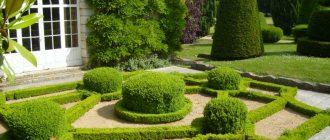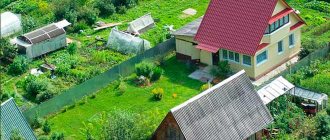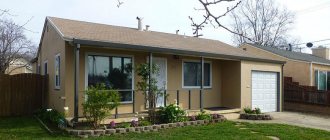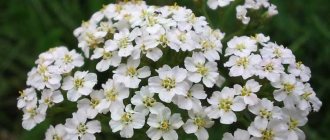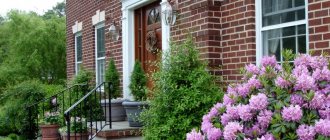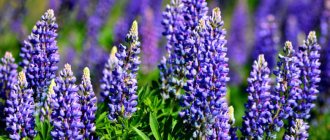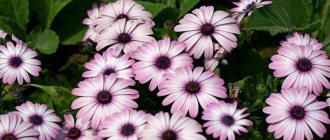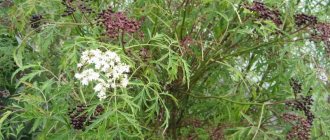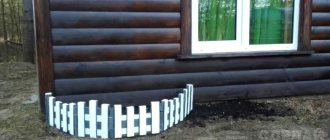Conifers are a decoration for any flower bed or garden. They can be combined with a wide variety of plants, creating original and unique compositions. Conifers in the garden can fit into any landscape, and they also emphasize the beauty of the plants adjacent to them. The variety of types allows you to select options for each specific case.
In landscape design, plants from the Coniferous department play an important role.
Features of garden design with conifers
The popularity of coniferous plants for garden or flower bed decoration is explained by the fact that they remain green throughout the year, unlike deciduous ones. This allows you to enliven the space, giving it a majestic appearance. The advantage of such green spaces is that they do not require special care, grow on a wide variety of soils, and many of the species are shade-loving. This allows you to use them to decorate any area of the yard.
Accents made by coniferous plants can make the garden very beautiful and impressive.
To create an original design in a garden or on a site, you should take into account some design features:
- The size that the plants will reach after some time is taken into account. You should not plant large trees on a miniature plot, but on a large plot the dwarf forms will be visually lost.
- The shape of the plant and the correct ratio of geometric proportions are important. For example, short and voluminous conifers can be planted along straight paths in the garden, and a pond can be combined with medium-sized decorative coniferous trees.
- It is necessary to decide whether the conifers will act as an independent composition or form a background for flowering plants.
Interesting. Conifers secrete essential oils and phytoncides, the inhalation of which has a beneficial effect on the human body.
Red, weeping, with yellow cones... Miracles of selection
It is obvious that the current abundance of coniferous varieties provides enormous opportunities for garden creativity. But at the same time, it spoils us - what yesterday seemed inaccessible and desirable, today loses its relevance and becomes a thing of the past - such is the pace of our lives.
Breeders around the world are actively working on a coniferous assortment for the near future, combining the best qualities of existing varieties. Perhaps very soon such wonders will appear as weeping forms with yellow or red growths, columnar and at the same time miniature, serpentine and at the same time dwarf, strewn with unusual cones... Any unimaginable combinations are possible - nature has not yet fully revealed its coniferous secrets to us. I am glad that Russian lovers have also joined in the creation of new varieties, albeit in small numbers, but the trouble has begun!
Main types of conifers
In order to choose the right coniferous plants for your garden, you need to know and take into account the characteristics of each of the existing species. This will allow you to correctly combine them with each other, creating a unique design.
A pleasant feature of conifers is their relatively unpretentious appearance.
Juniper
It is a shrub that can have a wide variety of shapes (tree-like, bush-like, creeping), and differ in the color of its needles and fruits. Loves sun and grows well in well-drained soil. Does not require special care or attention after planting.
Even a person who is not particularly experienced in design can successfully fit them into the landscape.
Thuja
It is especially popular among gardeners and summer residents due to the ability to easily form a crown and propagate using cuttings. Thuja saturates the air with pine scent and beneficial substances. This dacha conifer easily tolerates frost, but requires regular shaking off the snow from the branches. Provided there is good drainage, the plant can withstand not only cold, but also drought, prolonged rains and other unfavorable conditions.
Evergreen thujas are very attractive and easy to care for.
Pine
It can grow in a wide variety of soils, but requires well-lit areas. There are many varieties that differ in size (from 50 centimeters to several meters in height), variety of seedlings, and color of needles. The most popular species is mountain pine, which is the most unpretentious and does not require special care.
Pine is highly resistant to drought, so it does not need watering, as natural precipitation is sufficient for it.
Spruce
It is recommended to plant at some distance from the house and other buildings, since the plant has an extensive root system that can harm them. Spruce grows well in areas with sufficient lighting. Blue spruce, which has the original color of its needles, is popular.
Spruce is simply a stunning tree for an ornamental garden.
Fir
It has an interesting and attractive appearance, and is also distinguished by its healing properties, which make it popular among gardeners and summer residents. There are more than 50 species, among which preference is given to low-growing, dwarf and creeping varieties. The plant grows well in any soil, but does not tolerate wind well. Fir also reacts to air purity, so it is suitable for dachas that are located far outside the city limits.
Fir is a persistent plant that takes root well at any time of the year.
Larch
A special species that sheds its needles with the onset of winter. Larch prefers fertile, well-drained soils, and is also very demanding in terms of good lighting (with the exception of the Japanese category).
Larch decorates the garden with a variety of colors starting from the end of April.
Classification
Among the whole variety of conifers, a group of low plants is distinguished. It includes varieties whose age representatives (3-5 years of life) reach the height of a person and the width of his arm span.
Today, planting spruce, pine and juniper trees in the country is becoming increasingly popular. Such compositions fit harmoniously into almost any plot or garden design, complementing the overall picture with bright colors and unusual textures. When choosing them, it is worth paying attention to some features of the growth of these samples.
Nana, dwarf, prostrata - the presence of one of these forms in the name of the variety indicates its short stature.
Dutch gardeners, based on annual height growth, use a conditional breakdown of all conifers into the following categories:
- Full-grown - about 30 cm per year.
- Medium height (semi-dwarf) – 15-30 cm.
- Dwarf - no more than 15 cm.
- Mini dwarf - up to 10 cm.
- Micro dwarf - up to 5-8 cm, some grow no more than 3 cm per year.
Use of coniferous plants by height
Conifers in a summer cottage can have very different heights. This parameter is one of the most important; it should be taken into account when selecting varieties for decorating a garden or plot. The following types of conifers exist:
- Tall. Various types are used to decorate a large area and serve as an excellent background for other plants. In a small area, you can plant one tree, which in a few years will become its main accent. The most popular tall conifers are plants with the following names: Skyrocket juniper, Hoopsii spruce, Brabant thuja, plain fir, Canadian yew, European pine and others.
- Medium size. Used to design paths and create unique compositions. The most commonly used are Konika spruce, mountain pine and Pug pine, as well as oriental thuja, yew and others.
- Short. They are compact in size and are an indispensable element of garden compositions. Popular ones are Thuja Amber Glow, Thuja Danica, Thuja Hoseri. Conifers are low-growing in the garden and their design photos can be found on the Internet.
- Creeping or creeping. Most often they are used to create a “spiky lawn” or original borders. The most popular types: Blue Chip juniper, Green Carpet juniper, Depressa Aurea juniper.
Interesting. To form an aesthetic crown in fast-growing trees, pruning, shearing and pinching are used.
It should be borne in mind that when creating any composition in the garden using conifers, they are planted first, and then all other species.
An important advantage of coniferous plants is the consistency of their appearance at different times of the year.
Keeping up with fashion - “nanoconiferous”
As you know, there are no limits to imagination. Subminiature varieties, plants that are barely the size of a tennis ball at maturity, are becoming increasingly popular. Over the course of a year, such “nanoconifers” give growth of a couple of millimeters. Coming from Eastern Europe, micro- and nano-conifers have already fallen in love with Russians, just like mini-rock gardens, troughs with mini-gardens made of natural stone.
A stone trough is an ideal home for growing nanos.
Agree that decorating, say, the front entrance to a country house or cottage with such exquisite landscape elements creates an unforgettable and original image, emphasizing the excellent taste and wealth of the owner.
Growing nanoconifers requires some effort: the most important operation is regular cleaning of the insides of the crown from the remains of dead needles. Plants are so small that they cannot independently get rid of the debris accumulated inside. By rotting, it becomes a tasty environment for the development of harmful insects and pathogenic fungi, which can ultimately destroy the fragile plant. To clean the crown, toothpicks and cosmetic sticks are used to remove makeup, as well as cans of compressed air to blow out any remaining debris.
Nanoconifers do not like elevated temperatures and direct sun, so during periods of drought they should be shaded and watered abundantly. If you follow these simple rules, you can create completely unusual fantasy mini-gardens, not only in rock gardens and stone containers, but also built into various landscape structures - stone fences, terraces, balconies, stairs, even directly into protruding parts of buildings.
Typical representatives of this group: common spruce varieties 'Vichtel'
,
'Cukrak'
, mountain pine
'Přerov'
,
'Veverka'
, Canadian hemlock '
Minute',
micro-varieties of lawson cypress
'Gnome'
, '
Bregeon'
, blunt cypress '
Uniperoides Compacta'
, '
Elf'
,
'Golden Sprite'
, junipers '
Echiniformis'
, '
Berkshire'
, '
Newman'
, '
Blue Pygmy'.
Obviously, the popularity of such solutions will only increase, so now you can look for miniature pearls, because they grow extremely slowly, are difficult to reproduce and, therefore, their cost is very high.
Where is the best place to plant coniferous plants on the site?
Each type of conifer has its own characteristics and the best combination options. Dwarf species look great on hills, and medium-sized ones are planted as the main plants of flower beds. There are many photos of the location of conifers in the garden.
A garden or park will be attractive not only in summer, but also in winter.
The location of conifers on a site depends on its size. In large areas, you can plant plants anywhere, using them as a backdrop. Alpine slides are created with conifers or used in flower beds located in front of the house. Conifers can be planted near the gazebo and along the paths. A small area can also be decorated with conifers by planting several bushes or a low-growing coniferous tree near the house.
The crown of most conifers has the correct shape; it does not require too frequent procedures for its formation and pruning.
Options for compositions of coniferous plants in garden landscape design
Coniferous plants can be used both as independent elements and as part of compositions. A flowerbed can be composed of one or more types of conifers. Particularly popular are descriptions and diagrams of the combination of coniferous plants with a spherical and conical shape with deciduous ones.
The root system of most coniferous plants allows them to survive for a long time without watering and grow on poor soils.
The main part of the flower bed can be a spreading bush or tree, which is planted in the central part. Lower plants are distributed around it.
The aroma of coniferous plants is pleasant and beneficial for humans.
It is not recommended to plant bright flowers next to evergreens, as this can distract attention from the main detail of the composition.
They can be used to solve almost all design problems in gardens or parks.
Flaws
The main disadvantages, based on the experience and reviews of experienced gardeners, are the following:
- Low resistance to fungal diseases, the need to use fungicides.
- Risk of damage to branches and crown as a whole.
- Short lifespan of some varieties.
- Problematic propagation by cuttings.
- The possibility of burning of young needles when exposed to direct sunlight during peak hours in the spring and summer.
Tips and tricks for decorating a garden with conifers
To create a stylish landscape in the garden, you should follow some recommendations:
- carefully consider the selection of trees and other plants so as not to disturb the compositional style;
- lawn grass or gravel is used as a background for conifers;
- Conifers should not be watered frequently. The older the tree, the less it needs watering;
- Roses should not be planted next to conifers. Conifers acidify the soil and roses die.
Conifers in the country not only look attractive, but also make the air cleaner. With their help, you can make a hedge, divide the area into zones, and create original islands and flower beds. Conifers combine with a variety of plants, so the options for using them are endless.
Unfading conifers radically change the appearance of the garden, making it brighter and unforgettable.
